 THE MINERAL WAVELLITE
THE MINERAL WAVELLITE
- Chemistry: Al3(PO4)2(OH)3-(H2O)5, Hydrated Aluminum Phosphate Hydroxide
- Class: Phosphates
- Uses: only as mineral specimens
Specimens
PHYSICAL CHARACTERISTICS:
- Color is characteristically green but also white, colorless, yellow and brown.
- Luster is vitreous.
- Transparency crystals are transparent to translucent.
- Crystal System is orthorhombic; 2/m 2/m 2/m
- Crystal Habit is almost exclusively radiating acicular crystals forming globules or botryoidal masses.
- Cleavage is perfect in two directions.
- Fracture is uneven.
- Hardness is 3.5 - 4.
- Specific Gravity is approximately 2.3+ (light even for translucent minerals)
- Streak is white.
- Associated Minerals are quartz, micas, turquoise and limonite.
- Other Characteristics: surface of globules often have minute crystals giving off tiny sparkles.
- Notable Occurances include Arkansas and Pennsylvania, USA; Bolivia and England.
- Best Field Indicators are crystal habit, green color and softness.
 Amethyst Galleries' Mineral Gallery MINERALS |

WAVELLITE specimen wav-1
$ 40.00
$ 40.00
Dims: 5" x 4" x 1-3/4"
Wt: 1 lb., 1.7 oz
North Bay, Ontario, Canada(?)
Though not as richly colored as some of the Wavellites that I've seen, this specimen has over 50% of its surface area covered with the mineral. The unusual formation of the host rock leads to even more unusual formations for the Wavellite, which basically coats whatever shape the decaying Basalt matrix takes. There are lots of botryoidal and radial formations that give the collector neat stuff to look at, too! This piece gives you a sizable amount at the price.

wav-1 ($ 40.00)
North Bay, Ontario, Canada(?)
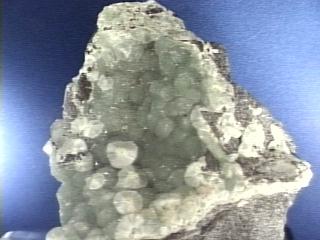
WAVELLITE specimen wav-2
$ 50.00
$ 50.00
Dims: 5" x 4-1/2" x 1-1/2"
Wt: 11.2 oz
North Bay, Ontario, Canada(?)
The Wavellite in this little treasure is mostly unfractured, making a botryoidal crust that covers about 1/3 of the surface area of the specimen. In the middle of the face, three spheres rest atop the crust. They are split in half, showing the radial beauty that makes Wavellite so popular among collectors. This radial effect is also visible along the outer edge of the crust. This is an impressive specimen!

wav-2 ($ 50.00)
North Bay, Ontario, Canada(?)
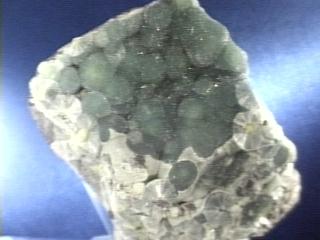
WAVELLITE specimen wav-3
$ 60.00
$ 60.00
Dims: 4" x 4" x 2"
Wt: 1 lb., 0.5 oz
North Bay, Ontario, Canada(?)
I like this Wavellite specimen best of all because it has lots of visible "wheels" of radiating crystals. They show the structure of the spherical aggregates very well, giving the collector some clues as to how they formed. There are also a few aggregates that did not break open that have a beautiful dark green color which I think looks really neat. This is a pretty specimen of an uncommon mineral, and affordable.

wav-3 ($ 60.00)
North Bay, Ontario, Canada(?)

WAVELLITE specimen wav-4
$ 125.00
$ 125.00
Dims: 3-1/2" x 2-1/4" x 1-1/2"
Wt: 3.18 oz
near Hot Springs, Arkansas, U.S.A.
I have not seen yellow wavellite from Arkansas before... I like it! There seems to be a small amount of limonite matrix attached to the underside of the specimen, but it is not nearly as soft as most of the limonite that I have experienced. The limonite is nestled in crevices on the underside of a crust of pale yellow botryoidal wavellite clusters. These clusters show damage only on the edges of the specimen, where it was broken out of its birthplace. The breaks show the cross-section of a typical cluster and the fibrous radial habit of the Wavellite, with its waxy luster. The clusters intersect each other in ways that create some deep crevices, and at least one cluster is hollow, creating a "vug". This is an excellent specimen!

wav-4 ($125.00)
near Hot Springs, Arkansas, U.S.A.
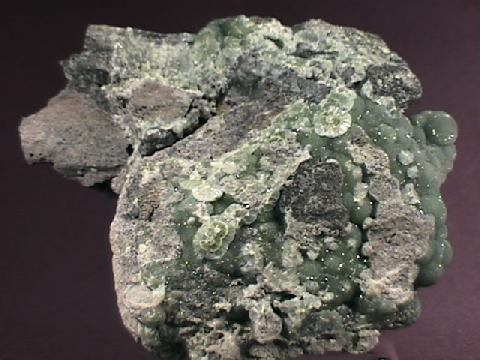
WAVELLITE specimen wav-5
$ 40.00
$ 40.00
Dims: 4.5" x 3.3" x 2.7" (11.4 x 8.4 x 6.9 cm)
Wt: 1 lb., 0.6 oz. (471 g)
near Hot Springs, Arkansas, U.S.A.
This large hand specimen consists of scores of intergrown, radiating Wavellite clusters that form a botryoidal crust which partly coats the dull, gray-brown host rock. Most of these clusters are incmplete due to intergrowth or broken, but such breakage allows the viewer to see their fibrous, radiating habits. They all have a moderately pale green coloration and show a dull, almost satiny luster on their intact surfaces. Those whose cross-sections are exposed and visible show a pearly luster that glints off of individual crystals. Some of the broken and more exposed formations show a dim translucence, but to all intents and purposes, the material is opaque.


wav-5 ($ 40.00)
near Hot Springs, Arkansas, U.S.A.
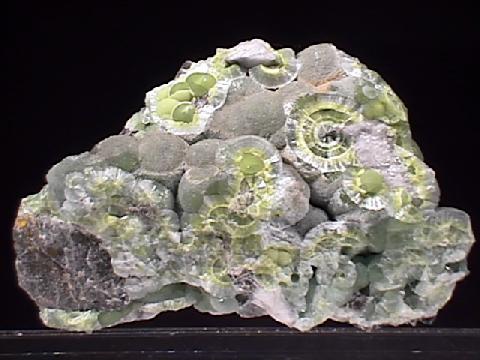
WAVELLITE specimen wav-6
$ 40.00
$ 40.00
Dims: 3.5 x 2.4 x 1.6" (8.9 x 6.1 x 4.1 cm)
Wt: 7.4 oz. (209.6 g)
Mauldin Mountain, Montgomery County, Arkansas, U.S.A.
This lovely specimen consists of a limestone base rock that is heavily encrusted with many round, intergrown nodules of compact, acicular Wavellite crystals. These nodules do not exceed 0.6" (1.5 cm) in diameter, and most are damaged or broken. However, this enables one to easily study their interiors and internal structure, and allows one to see that their growth occurred in stages, forming two or more concentric layers. A few of the larger orbs contain 3 or even 4 layers, and all are made up of compact, fibrous crystals that are so thin and compact that it is essentially impossible to study their form. The nodules have a moderately pale green coloration on their exteriors, and their interiors vary in coloration by layer. The crystals visible due to damage possess a pearly luster, whereas the outer surfaces of the intact clusters have a luster that ranges from dull to silky. All are either opaque or dimly translucent.
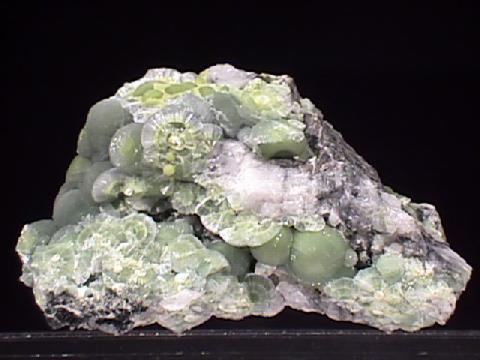

wav-6 ($ 40.00)
Mauldin Mountain, Montgomery County, Arkansas, U.S.A.

WAVELLITE specimen wav-7
$ 60.00
$ 60.00
Dims: 4.0 x 2.6 x 0.9" (10.1 x 6.6 x 2.3 cm)
Wt: 5.82 oz. (165.3 g)
Mauldin Mountain, Montgomery County, Arkansas, U.S.A.
A botryoidal Wavellite crust coats a portion of the pale gray host rock of this hand specimen. The crust is made up of intergrown Wavellite clusters that reach diameters of 0.7" (1.8 cm) and are generally in good condition. Each cluster is made up of heavily intergrown, radiating crystals whose slender orthorhombic bladed forms are almost impossible to study. A few of the clusters have been broken, revealing the radial nature of the crystals, and showing a dull pearly luster. Intact clusters have a moderately dark green coloration, though their interiors tend to have a much paler color. Some of the smaller clusters are translucent, but the largest ones are essentially opaque. The host rock on which they rest appears to be made of shale or a weathered slate, and a few other small or partial Wavellite clusters are scattered on it or wedged in cracks.

wav-7 ($ 60.00)
Mauldin Mountain, Montgomery County, Arkansas, U.S.A.
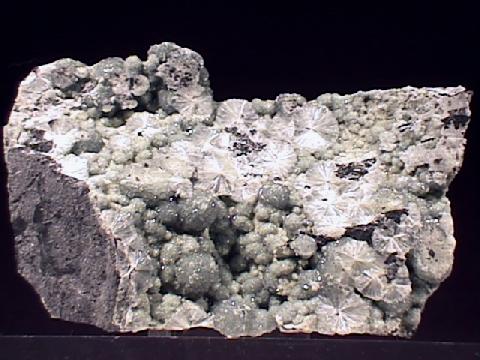
WAVELLITE specimen wav-8
$ 30.00
$ 30.00
Dims: 4.0 x 2.6 x 1.5" (10.1 x 6.6 x 3.8 cm)
Wt: 7.25 oz. (205.7 g)
Montgomery County, Arkansas, U.S.A.
Scores of round Wavellite clusters rest on the dark gray host rock of this specimen. They range in diameter from 1 or 2 mm to nearly 0.5" (1.3 cm). Most of them are broken or heavily damaged so that one can see the compact, radial habit of the individual crystals. These crystals are a bit too intergrown to study effectively, but the rounded clusters are uniform and symmetrical, which suggests that the crystals are reasonably well-formed. All have a pale green coloration and a pearly luster, though intact clusters have a deeper green surface that is rather dull in luster.

wav-8 ($ 30.00)
Montgomery County, Arkansas, U.S.A.
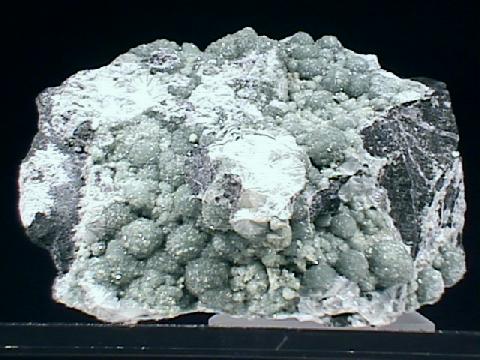
WAVELLITE specimen wav-9
$ 40.00
$ 40.00
Dims: 4.0 x 2.9 x 2.2" (10.2 x 2.9 x 2.2 cm)
Wt: 12.2 oz. (346 g)
Montgomery County, Arkansas, U.S.A.
Several dozen small Wavellite clusters rest on the dark gray limestone base of this hand specimen. Several are broken and a few others are considerably damaged, but most are intact and in very good condition. They reach diameters of up to 0.4" (1.0 cm) and each consists of dozens of compact, radiating Wavellite needles that can be seen best where nodules are broken. All have the standard pale green coloration of Wavellite from this locality- the interior material tends to be paler in color than the outer surface of each cluster. The host rock is almost black in coloration but has a few pale gray veins running through it.

wav-9 ($ 40.00)
Montgomery County, Arkansas, U.S.A.
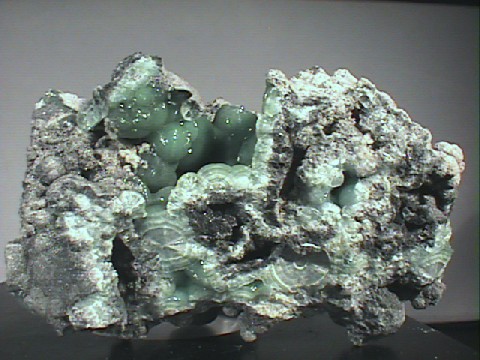
WAVELLITE specimen wav-10
$ 40.00
$ 40.00
Dims: 3.3 x 2.4 x 1.9" (8.3 x 6.1 x 4.9 cm)
Wt: 6.7 oz. (189 g)
Mauldin Mountain, Mount Ida, Montgomery County, Arkansas, U.S.A.
Several botryoidal crusts of compact, radial Wavellite clusters rest on the gray limestone host of this cabinet piece. Though many of these crusts appear to be separate, I believe that all intersect each other at various points. The largest crust is in excellent condition and is normally about 0.2-0.3" (5-8 mm) thick. Each crust is made up of many round, intergrown nodules which are in turn made up of countless tiny, compact, radiating Wavellite needles. The surface of each crust has a deep green color and a bright, silky luster; their cross-sections show a paler green color and a pearly luster. I believe that some of the crusts have been covered by the gray limestone.

wav-10 ($ 40.00)
Mauldin Mountain, Mount Ida, Montgomery County, Arkansas, U.S.A.
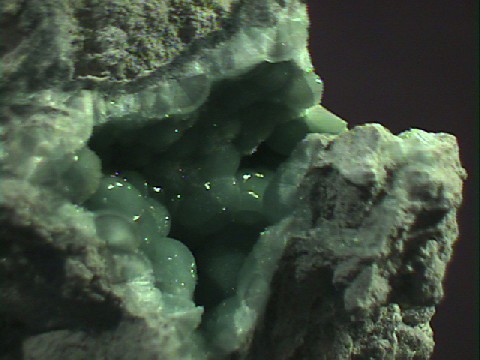
WAVELLITE specimen wav-11
$ 35.00
$ 35.00
Dims: 2.8 x 2.6 x 1.7" (7.0 x 6.7 x 4.2 cm)
Wt: 3.9 oz. (111 g)
Mauldin Mountain, Mount Ida, Montgomery County, Arkansas, U.S.A.
This cabinet specimen consists of a chunk of gray limestone in which rests a crust of compact, radiating and botryoidal Wavellite. This crust is in excellent condition, showing no appreciable damage, and is not more than 0.3" (8 mm) thick. This crust is made up of scores of intergrown globules, each of which is in turn made up of countless compact, radiating needles. The nodule surfaces show a dark green color and a vitreous sparkle, but their cross-section shows needles with a paler green color and a pearly luster. There are a few other partial crusts on the piece, but these are visibly damaged.

wav-11 ($ 35.00)
Mauldin Mountain, Mount Ida, Montgomery County, Arkansas, U.S.A.
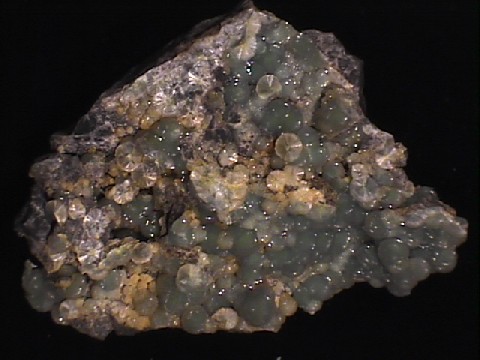
WAVELLITE specimen wav-12
$ 105.00
$ 105.00
Dims: 4.57x3.43x1.26" (11.6x8.7x3.2cm)
Wt: 9.12oz. (258g)
Mauldin Mountain Quarry, Montgomery County, Arkansas, USA
Hundreds of lovely green balls of wavelite cover the top of this specimen. Most are complete and undamaged, although heavily intergrown, and a dozen or more of the ballshave been cleaved off, revealing the radial growth of the wavelite inside each globe. Most of the wavelite is a lovely pale green, although some smaller crystals (and especially the broken ones) appear yellow.
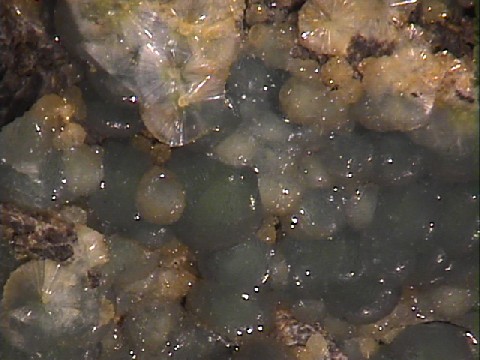

wav-12 ($105.00)
Mauldin Mountain Quarry, Montgomery County, Arkansas, USA

WAVELLITE specimen wav-13
$ 120.00
$ 120.00
Dims: 3.46x3.35x2.01" (8.8x8.5x5.1cm)
Wt: 15.91oz. (450.2g)
Mauldin Mountain Quarry, Montgomery County, Arkansas, USA
The wavellite on this host rock apparently began as yellow crystals which were overgrown with green crystals. This is only apparent on the edges of the specimen where either a side view is available, or where the top of the ball has cleaved away, revealing a yellow core. Most of the wavellite is a pale green tending towards teal in hue. The smaller globes look lighter in color. All of the wavellite is in the form of radial clusters of crystals in a botryoidal habit with excellent vitreous luster. Along the edges, it is apparent that the crystals are transparent near the outside of each sphere, with the color deepening towards the center. Some of the globes have translucent bright yellow centers. There are portions of other minerals atop the wavellite, some large enough to be readily visible, others as small crystals that just serve to obscure some of the otherwise excellent wavellite.
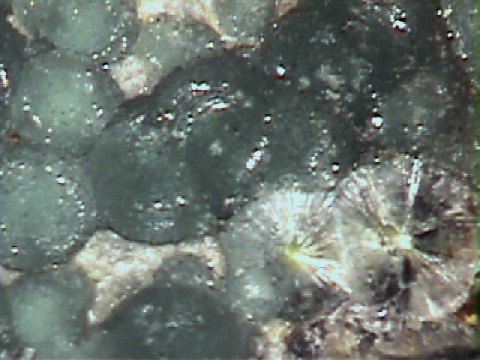

wav-13 ($120.00)
Mauldin Mountain Quarry, Montgomery County, Arkansas, USA
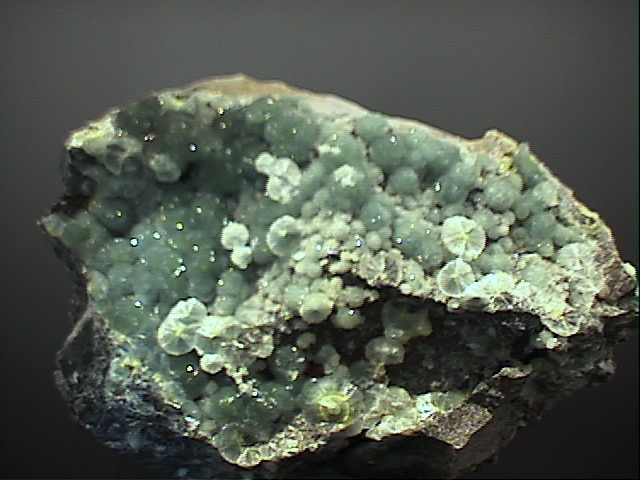
WAVELLITE specimen wav-14
$ 75.00
$ 75.00
Dims: 5.00x3.52x2.19" (12.71x8.94x5.56cm)
Wt: 21.59oz (612g)
Mauldin Mountain Quarry, Montgomery County, Arkansas, USA
This wavellite specimen has an exceptional lime-green color, undoubtedly due to the exceptional clarity of the wavellite. A loupe reveals that these hundred balls of wavellite are composed of radial clusters of transparent green crystals, although in some areas the wavellite is nearly colorless, and in others appears yellow. Actually, many of the open clusters appear to have a core of yellow wavellite, surrounded by the green. This is one of those specimens where the damage reveals the internal structure of the crystal clusters, and improves the quality of the specimen.
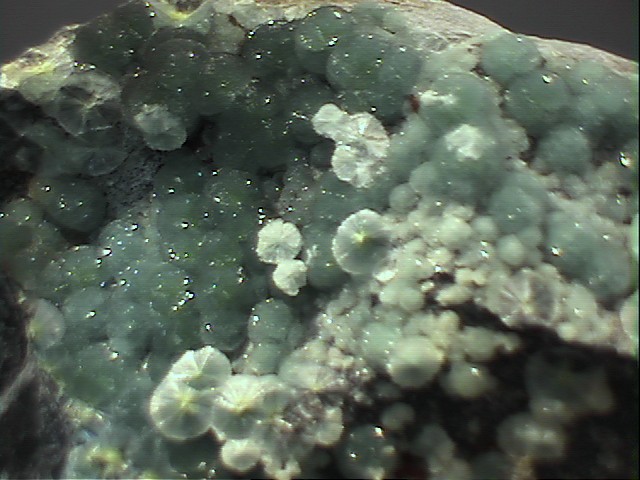

wav-14 ($ 75.00)
Mauldin Mountain Quarry, Montgomery County, Arkansas, USA
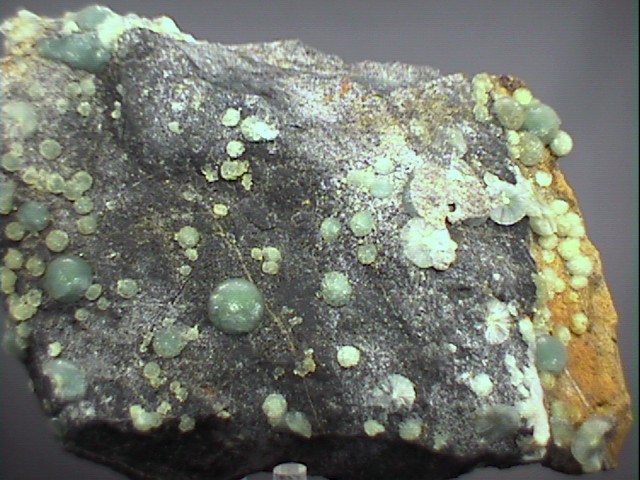
WAVELLITE specimen wav-15
$ 45.00
$ 45.00
Dims: 6.11x3.71x1.82" (15.52x9.43x4.64cm)
Wt: 2.85oz (80.8g)
Mauldin Mountain Quarry, Montgomery County, Arkansas, USA
This large wavellite specimen boasts dozens of balls of wavellite, most of which have a translucent green color and (superficially) a silky luster. I say "a superficially silky luster" because a loupe reveals that the play of light on the surface is simply caused by thousands of stepped crystal faces, each at a slight angle to its neighbors, resulting in the play of light. Many of the smaller crystals have a yellow-green, or even greenish-yellow color, some tinted white (primarily the smallest clusters). While many of the clusters have broken open, showing their radial structure, only a few crystals exhibit damage, including the two largest crystals which each show a small white area where the crystals were dinged.
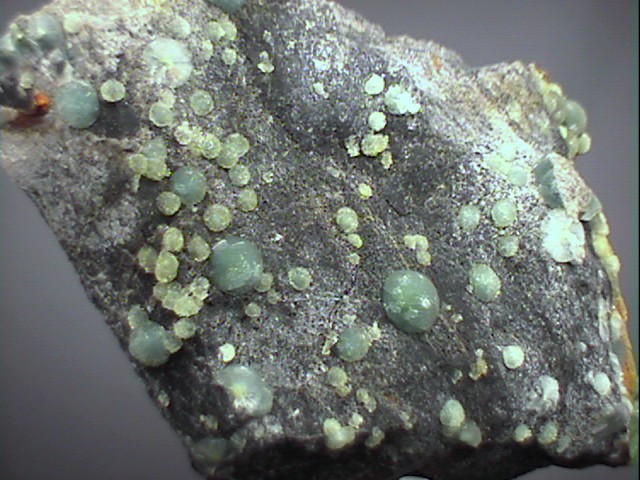

wav-15 ($ 45.00)
Mauldin Mountain Quarry, Montgomery County, Arkansas, USA

WAVELLITE specimen wav-16
$ 30.00
$ 30.00
Dims: 2.28x1.97x0.53" (5.79x5.01x1.35cm)
Wt: 1.28oz (36.3g)
Willard Mine, Lovelock, Nevada, USA
A colorfully stained black host rock is nearly covered by a thin crust of white wavellite crystals plus dozens of small green balls of wavellite. The few broken clusters are the prettiest, as they show the radial growth of the fine acicular crystals and reveals that they are nearly colorless and have a silky luster.


wav-16 ($ 30.00)
Willard Mine, Lovelock, Nevada, USA

WAVELLITE specimen wav-17
$ 25.00
$ 25.00
Dims: 4.23x2.39x1.89" (10.73x6.07x4.79cm)
Wt: 12.73oz (361g)
Mauldin Mountain Quarry, Montgomery County, Arkansas, USA
Superficially, this specimen is fairly ugly. While there is a lot of wavellite present, it is mostly broken clusters - only a few of the balls of wavellite are undamaged. These have a lovely green color and an appealing luster due to the crystal pattern on the surface. Close examination does show that some of the wavellite is yellow, some colorless, and the broken radial clusters reveal that several are multi-colored, with yellow centers and green exteriors, or green interiors and colorless exteriors. I found one cluster that showed colorless in the center, then a band of yellow, then a band of pale green. Very interesting, and pretty (at least when viewed with a loupe).


wav-17 ($ 25.00)
Mauldin Mountain Quarry, Montgomery County, Arkansas, USA